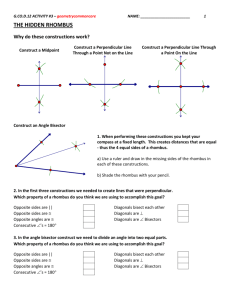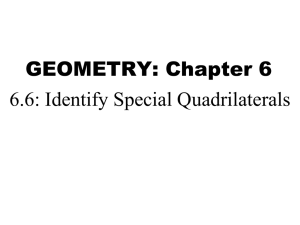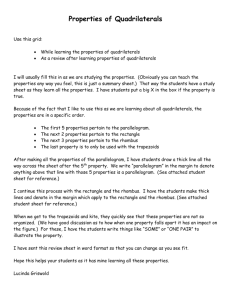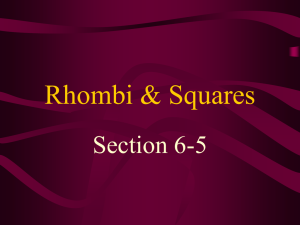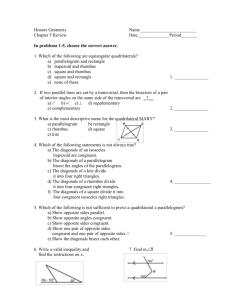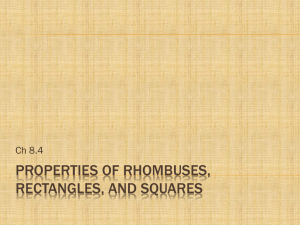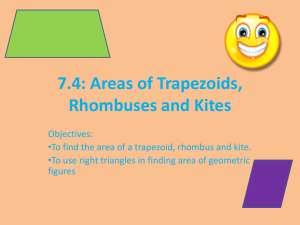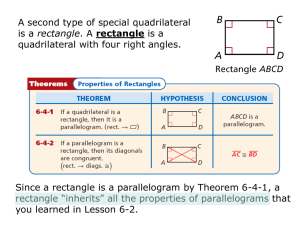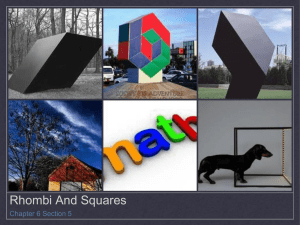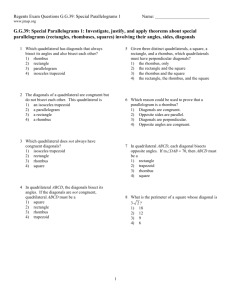Constructing a Rhombus
advertisement
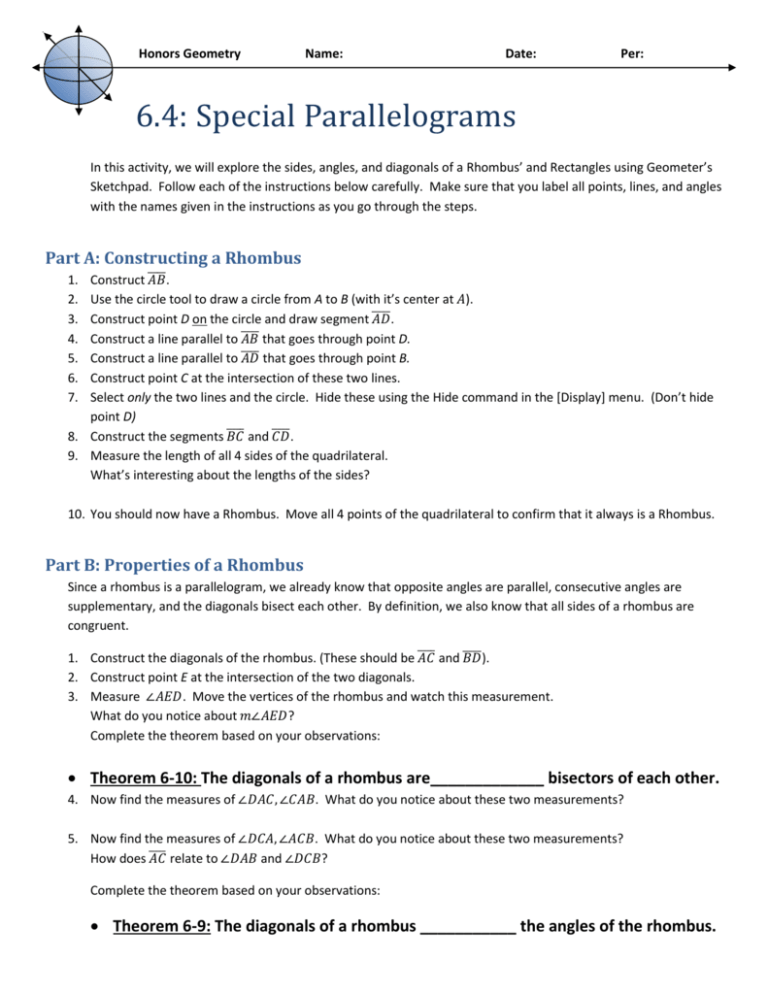
Honors Geometry Name: Date: Per: 6.4: Special Parallelograms In this activity, we will explore the sides, angles, and diagonals of a Rhombus’ and Rectangles using Geometer’s Sketchpad. Follow each of the instructions below carefully. Make sure that you label all points, lines, and angles with the names given in the instructions as you go through the steps. Part A: Constructing a Rhombus ̅̅̅̅. Construct 𝐴𝐵 Use the circle tool to draw a circle from A to B (with it’s center at 𝐴). Construct point D on the circle and draw segment ̅̅̅̅ 𝐴𝐷. ̅̅̅̅ Construct a line parallel to 𝐴𝐵 that goes through point D. Construct a line parallel to ̅̅̅̅ 𝐴𝐷 that goes through point B. Construct point C at the intersection of these two lines. Select only the two lines and the circle. Hide these using the Hide command in the [Display] menu. (Don’t hide point D) ̅̅̅̅ and 𝐶𝐷 ̅̅̅̅. 8. Construct the segments 𝐵𝐶 9. Measure the length of all 4 sides of the quadrilateral. What’s interesting about the lengths of the sides? 1. 2. 3. 4. 5. 6. 7. 10. You should now have a Rhombus. Move all 4 points of the quadrilateral to confirm that it always is a Rhombus. Part B: Properties of a Rhombus Since a rhombus is a parallelogram, we already know that opposite angles are parallel, consecutive angles are supplementary, and the diagonals bisect each other. By definition, we also know that all sides of a rhombus are congruent. 1. Construct the diagonals of the rhombus. (These should be ̅̅̅̅ 𝐴𝐶 and ̅̅̅̅ 𝐵𝐷). 2. Construct point E at the intersection of the two diagonals. 3. Measure ∠𝐴𝐸𝐷. Move the vertices of the rhombus and watch this measurement. What do you notice about 𝑚∠𝐴𝐸𝐷? Complete the theorem based on your observations: Theorem 6-10: The diagonals of a rhombus are_____________ bisectors of each other. 4. Now find the measures of ∠𝐷𝐴𝐶, ∠𝐶𝐴𝐵. What do you notice about these two measurements? 5. Now find the measures of ∠𝐷𝐶𝐴, ∠𝐴𝐶𝐵. What do you notice about these two measurements? ̅̅̅̅ relate to ∠𝐷𝐴𝐵 and ∠𝐷𝐶𝐵? How does 𝐴𝐶 Complete the theorem based on your observations: Theorem 6-9: The diagonals of a rhombus ___________ the angles of the rhombus. Part B: Properties of a Rectangle Since a rectangle is a parallelogram, we also know that the opposite sides are parallel, and the diagonals bisect each other. Let’s construct a rectangle and find out more about the diagonals. 1. 2. 3. 4. 5. 6. 7. (Challenge: If you can construct a rectangle on your own, do this, and skip to step 8) Draw segment ̅̅̅̅ 𝐴𝐵. Construct two lines that are perpendicular to ̅̅̅̅ 𝐴𝐵 that goes through the endpoints 𝐴, and 𝐵 Construct point 𝐶 on the line through point 𝐵. ̅̅̅̅ that goes through point 𝐶. Construct a line perpendicular to 𝐵𝐶 Construct point 𝐷 to complete the rectangle. Move all four vertices to be sure that it is always a rectangle. Now draw segments between points 𝐵, 𝐶, and 𝐷. Hide all the perpendicular lines. 8. Construct both diagonals. 9. Measure both diagonals. What do you notice about the length of the diagonals? Change the size of the rectangle to see if this is always true. Complete the theorem based on your observations: Theorem 6-11: The diagonals of a rectangle are _________________________.
